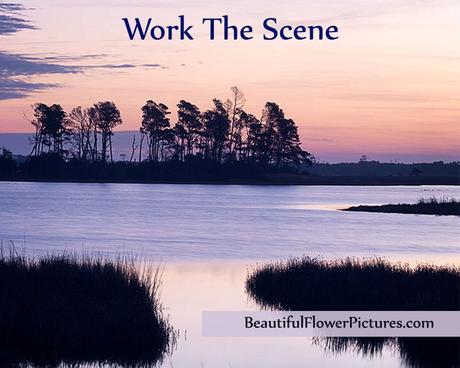
Have you ever stopped to photograph a great scene, and then when you got home realized that you would have had the perfect shot, if only you had gone wider, gotten in closer, been 3 feet to the left, etc? One of Bill's and my major recommendations to our students is that when you see that scene that catches your eye, and you decide you must photograph it, is that you work the scene.
What does this mean? When we approach a scene, often a shot will come to mind, and we set up and take that particular photograph. But once that is out of our systems, we stop and take a look at the scene with an eye towards what other shots we can compose.
So how can you do this? The first thing is to take a moment and look, with an eye towards what different compositions you can see. You can try several things that will help you think of different photos:
- Try different focal lengths. If you're looking through a telephoto lens, you will get very different compositions then when you are using a wide angle lens. We often start with a wide angle lens, then use a telephoto to pick out some of the more interesting details in the scene.
- Try portrait and landscape compositions. The change from horizontal to vertical orientation of your camera will force you to include and exclude different parts of the scene, and will help you to think about the scene in different ways.
- Move around and try again. Typically, when we are happy with a shoot in one spot, we'll pick up the tripod (you are using a tripod, aren't you?) and walk around to look at the scene from different angles. This keeps you from being stuck in one set of "tripod holes" never moving from one place. Walk ten feet/ a hundred feet/ a hundred yards (depending on your circumstances - you'd be amazed what a difference 10 feet can make in getting components of your scene to line up) and see if you like what you see. Set your tripod again and start seeing what shots look better from the new angle.
Please note that we regard working the scene as different from "machine gunning", or indiscriminately keeping your camera shooting without giving thought to what you are shooting. You still need to think about your composition, but any scene has more than one good composition in it (we've learned this extremely well - put the two of us in the same place with the same gear, and you will get very different compositions).
Here are some of Bill's photos from a sunrise in the marsh at Chincoteague National Wildlife Refuge.
What attracted Bill's attention to the original scene was the lovely light silhouetting the trees in the background, with the light reflected by the water in the foreground. In walking the scene before placing his tripod on the ground, he decided that the ideal place was where the channel of water in the foreground made a leading line into the scene (and you'll see that he kept that concept throughout). Throughout the shoot, he moved both camera right and camera left to try different compositions (not much here - probably 10-15 feet, so that he didn't lose the channel in the foreground). Bill shot several portrait compositions with a longer lens, and even tried to consider what might look good in black and white (so looking for form and tone as opposed to color).
Finally, at a point when the light was interesting across the horizon, he put on a moderately wide lens and shot a diptych to give a panoramic view across the marsh.
So, the next time you're out photographing a wonderful scene, and you've got what you think is the perfect shot in camera, step back for a moment and ask yourself "what other ways could I be photographing this scene?" Try a different lens (or zoom in/out if you have a zoom lens)? Change the camera orientation? Go photograph it from over there? Particularly if you are traveling to photograph, you don't want to wind up looking at your photos after the fact and saying "why didn't I try (zooming in/zooming out/ moving left/etc)?" So make sure you work the scene while you are there.
If you found the idea of working the scene helpful, it's one of the concepts Bill and I talk about our landscape photography workshops. Our next workshops are in Chincoteage National Wildlife Refuge on February 6-8, and in the Great Smoky Mountains National Park on April 26-30. We'd love to have you join us for one of our workshops.
